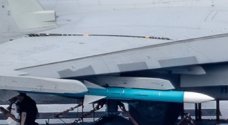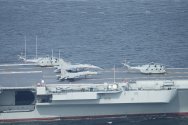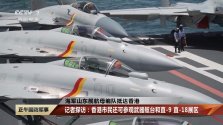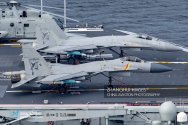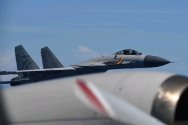You are using an out of date browser. It may not display this or other websites correctly.
You should upgrade or use an alternative browser.
You should upgrade or use an alternative browser.
J-15 carrier fighter thread
- Thread starter Jeff Head
- Start date
The issue I'm seeing with your graph is that the Su-33/J-15 top view has ECM pods, not launch rails, so its going to be slightly ticker than the T diagram which has rails.Hello everyone,
I'd like to discuss an issue regarding the J-15. The J-15 has a major flaw: its 3x2 pylons, including the wingtip ones, are located on the outer, folding section of the wings. This means the J-15 cannot be armed with weapons unless its wings are unfolded, which severely impacts deck operational efficiency. In contrast, aircraft like the F/A-18 series and the F-35C have most of their hardpoints on the non-folding section. This results in the J-15 having only 6 "quick-load" hardpoints available in its folded state: the 2 under-intake pylons, 2 wing-root pylons, and 2 centerline fuselage pylons, in addition to the 6 non-quick-load pylons on the folding wing sections.
Furthermore, there's another issue: the non-folding wing-root pylons can interfere with the main landing gear, imposing restrictions on the shape of the munitions.
However, I recently saw a diagram showing that the J-15T (the catapult-capable variant) has further reduced the width of its folded airframe from 7.4m (on the Su-33/J-15) to 7.1m. Doesn't this exacerbate the problem? Is this diagram authentic? What could be the reason for such a modification?
Marked out the differences between the J-15 and the J-15T on a photo by Zhanghui from its entry into HongKong this morning.
Sensors/Antennae in the first photo and other physical differences in the second. These are discounting slight changes in shape to the fuselage that could be due to the slightly different angles of the two jets, as well as paint/color.
Unfortunately my schedule is filled so I won't be able to go see it this weekend :/
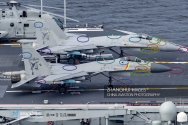
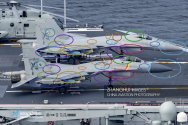
Sensors/Antennae in the first photo and other physical differences in the second. These are discounting slight changes in shape to the fuselage that could be due to the slightly different angles of the two jets, as well as paint/color.
Unfortunately my schedule is filled so I won't be able to go see it this weekend :/


Do we know if the J-15T (and by extension the J-16 too) has radars/etc. buried in the leading edge slats too?
View attachment 155409
Those in the leading edge slats aren't necessarily radars, but RF antennae, like ESM or EW.
Of the mainline Flanker family, from memory they began to be present on Su-30 variants (including MKKs for the PLA), and SAC Flankers after the J-11B family had those signs of RF antennae there as well (i.e.: J-15, J-15T, J-16, J-16D, J-15D etc).
From memory early Flankers of the USSR/Russia had RF antennae in leading edge root extension as standard, and then they were no longer present on Flankers after Su-30 and I wonder if they got supplanted by RF antennae in the leading edge slats (the leading edge root extension RF antennae looked much smaller in aperture than the leading edge slats).
As a derivative of the more original Su-27SK line, the J-11B family has RF antennae in the LERXs and none on the leading edge slats.
I can't recall if some more recent Flanker variants like Su-35 may have both LERX and leading edge RF antennae, but at that point it's just how many ways one wants to skin a cat, in context of one's RF technology and what missions you want your antennae to do.
Fairly common to see dielectric grey "strips" indicative of RF antennae on the leading edge slats of various aircraft (or LERXs if they have them) -- if one looks up J-20s, J-10Cs, J-35s in primer, for example.
==
(edit: actually going back on the images, J-16D and j-15D don't seem to have leading edge slat RF antennae strips, but they do revert to having LERX RF antennae patches of early Flankers... meanwhile J-16, J-15 and J-15T have both leading edge slat RF antennae strips as well as LERX RF antennae patches where the LERX meets the canards in the case of the latter two -- but all of slightly different patterns and sizes)
Last edited:
How many J-15 and J-15T have been produced so far?


